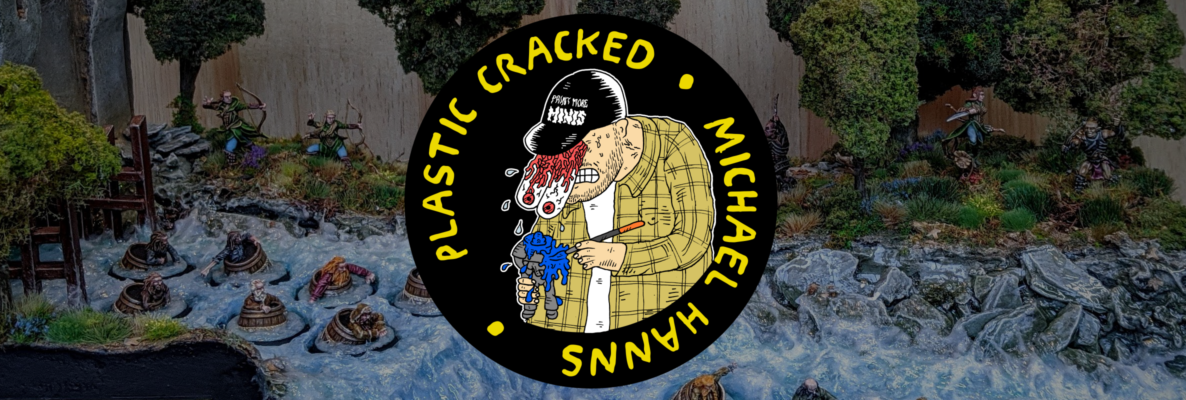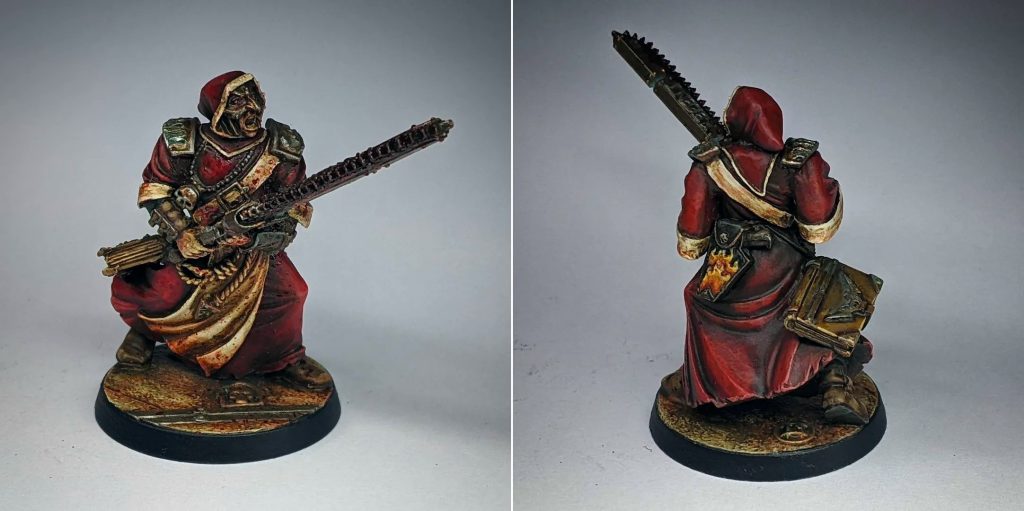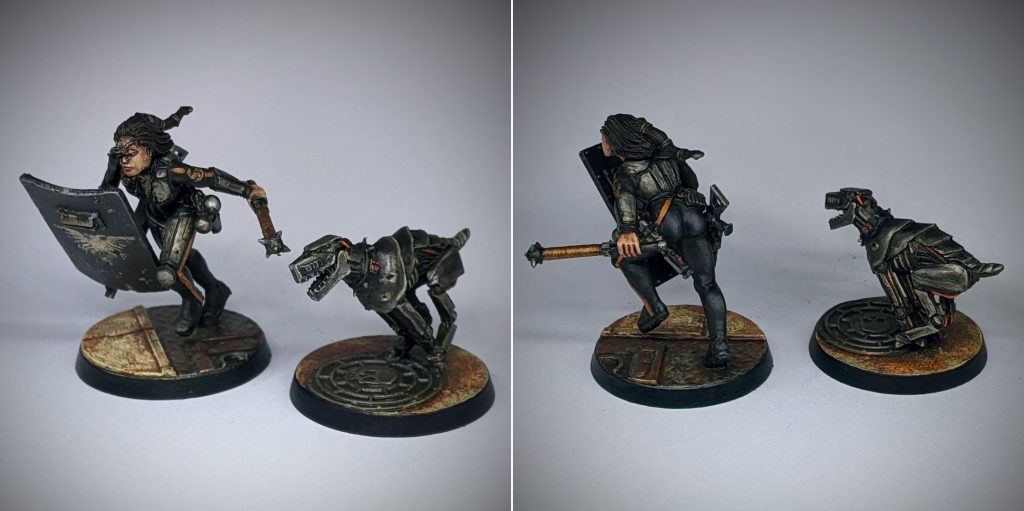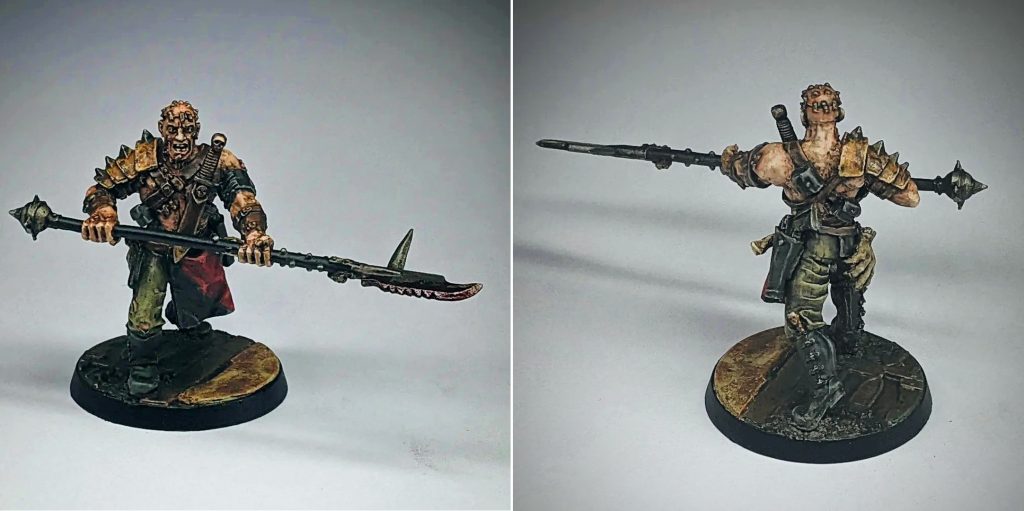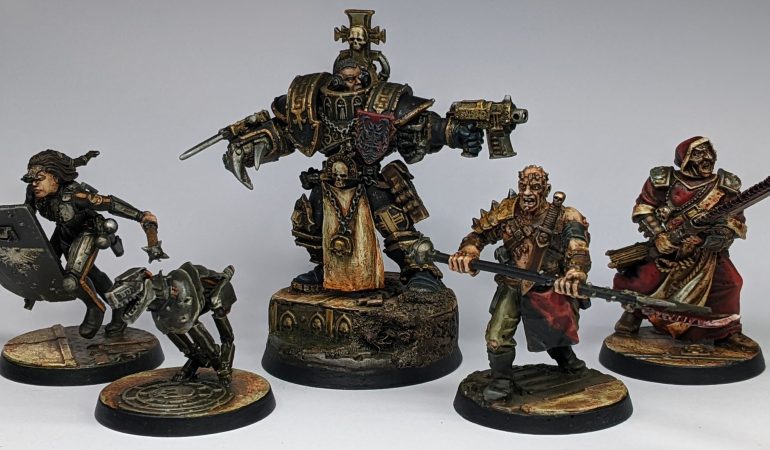
You may remember that a little under a year ago, I converted and painted an Inquisitorial warband for Warhammer 40,000. That was one of my most enjoyable hobby projects I’ve ever worked on, and they even made their way into White Dwarf issue 472.
After finishing the warband, I started suggesting to some of my friends that we should give the venerable Games Workshop narrative tabletop game Inquisitor a shot. At this point, the rules are free and since everything is measured in terms of feet (where a foot translates to an inch in the game usually), you could quite easily modify it for 28mm by using metric centimetres instead of inches. We never quite got around to playing Inquisitor in 28mm, but little did I know my friend Jojo was quietly buying up a small fortune’s worth of the old 54mm models in the meantime. He posits that the game would be easier to learn using some of the pre-rolled characters in 54mm – and then we could potentially move onto using our custom warbands in 28mm. Not only that, but all of this was revealed during a friendly game of Warhammer 40,000, wherein he reveals that he also purchased the full canonical warbands for Eisenhorn, Witch Hunter Tyrus and Covenant and offers me my choice of Tyrus or Covenant. I, of course, chose the purest of paths – the Ordo Hereticus.
Inquisitor 54mm is a fascinating, esoteric piece of Games Workshop history with so much to unpack about it. From a fluff perspective, the game brought with it a lot of the depth of information about the Imperium at large, it’s citizens and the various conflicting Ordos, sub-factions and theologies of the Inquisition. It gave us some of our earliest glimpses at several factions we now take for granted, such as the Adeptus Mechanicus, Genestealer Cults and the Deathwatch. At the time it was published, Inquisitor was probably the single best resource for learning more about the Imperium and the universe of Warhammer 40,000 from the perspective of boots on the ground. To this day, the rulebook and supplementary materials remain a compelling and valuable resource for anyone looking to go a little off the beaten path.
From a gameplay perspective, Inquisitor was an absolute enigma to me as a kid – and still is, to an extent, all these years later. I’d never really witnessed it in action in person, beyond catching a glimpse of some beautiful eye catching participation games in passing at a Games Day. I knew that it used D100s instead of D6s – I spotted them in the clear clamshell Inquisitor ‘starter packs’ nestled quietly on the bottom shelf of the Specialist Games corner of my local Games Workshop, but that was pretty much the extent of it. Many years later, I researched the game and.. it’s a bit difficult to explain.
In a nutshell, Inquisitor is a skirmish miniature game played with 3 or more players – a Game Master and 2+ players, each in control of one or more individual miniatures. The game, at it’s core, plays out in a similar fashion to other skirmish games such as Necromunda – you take turns moving your models individually with the intent to kill the opposing team or achieve some objective. The main difference with Inquisitor however, is the inclusion of the Game Master. This impartial 3rd party lets you get creative and play around with the possibilities and push against the boundaries of the ruleset. Wanna jump off a railing and onto your opponent? Demolish a structure to crush him with the debris? Jury-rig a trap with whatever is on hand? Disarm and capture? Lure them? Confuse them? Convince their followers to join you? Talk it out? Whatever crazy, creative solution you might have to a problem, you can probably work it out with the Game Master.
If that sounds like a tabletop RPG to you, well, you’re not entirely wrong. Inquisitor occupies a really weird kind of niche – it’s not really an RPG, there’s no ‘town’ section, exploration or dungeon crawling components to this. Depending on your perspective, it’s a bit like playing exclusively the combat set pieces from your RPG campaigns using miniatures and 3D terrain, or it’s like playing a skirmish wargame with way more scope for creativity.
While not exactly suitable for pick up games against a stranger, the Inquisitor system sounded like it could be a really fun memorable moment generator with the right set of people. This was my biggest motivator for picking up a copy of the rulebook from eBay, and for converting my 28mm warband in the first instance. Still, as convenient as playing the game in 28mm is, there’s something incredibly alluring about the hobby section of the rulebook. Seeing these chunky, 54mm miniatures and the ways in which hobbyists had converted their own models is really engaging and inspiring. Something about the size and scale of the miniatures just seemed to add to the drama, the immersion. Everything seemed that little bit more ‘zoomed in’, as befit the ruleset.
So, as you can imagine, I was over the moon to receive these miniatures – and I set about building the first of them right away.
Inquisitor models are a curious beast – at their best, they’re absolutely joyous works of art. Highly detailed miniatures in a scale that really gives the model room to breath, all with that unmistakable charm that comes with being hand sculpted from modelling clay. At their worst, they’re.. Well, they’re 20 year old models that even at the time of release had varying levels of quality. Some miniatures have aged like a fine wine, while others suffer from faces that recall Wallace and Gromit. Many lie somewhere in between – and one such model is Witch Hunter Tyrus.
As far as character design, proportions and even face detailing for Inquisitor models go, Tyrus is probably S tier – his face is well proportioned, with a strong jawline and realistic looking features while his artificer power armour cuts and imposing silhouette. There’s very little wrong with this miniature – with the one exception of his default pose. It’s not awful, but it does feel very of the time – it feels like they were going for stoic with his ‘at ease’ pose, but it completely fails to capture the drama of excellent artwork of Tyrus from the cover of the rulebook. Something about it feels too 2nd Edition 40K to me, which doesn’t befit the menace and threat that the character is supposed to embody. I knew I’d have to do something to the model.
I thought about trying to convert the miniature into the walking pose from the Inquisitor cover art, but honestly, that just seemed a little far out of my wheelhouse. Converting and reposing miniatures is difficult enough when they’re hollow plastic, but this was a solid lump of pewter. Instead, I decided to work with the pose of the miniature and go for something a subtle but impactful. I cut away at the inside of the joints on his bolt pistol arm with an old pair of sturdy clippers until enough of the mesh was removed that I could bend and repose the pewter and straightened out his pistol arm until it was outstretched as if to be aiming, then refilled the area with green stuff and sculpted the mesh back in myself. This was pretty easy for the inside of his elbow and wrist – it’s just carving straight lines in the putty after all – though required a little more effort closer to his shoulder where the cabling is a little more intricate. Fortunately, most of that work is concealed by his shoulder pads, anyway. With his pistol arm done, his power claw and head needed the most minimal of reposing in their socket joints to get a pose not a million miles off the Tariana Palos miniature for Adepta Sororitas.
I was really happy with how this model looked overall, but something just really seemed to be missing from it. Eventually it hit me – his armour really needed a tabard to complete the ‘crusader’ look. I managed to source an Inquisitor-scale tabard on eBay from Mechanicus Adept Delphan Gruss, which fit Tyrus pretty effortlessly with very minimal filing and green stuff needed to make it fit his armour. I replaced the little syringe looking trinket hanging from a chain with a spare skull trinket I had left from Tyrus’ kit, and my conversion was complete.
For a base, I decided to use Games Workshop’s Sector Imperialis bases on my Inquisitor models. They seemed pretty fitting aesthetically – I see these models fighting over the Imperial territory more than any other location. While the 40mm base size generally suits most of the Inquisitor range, I must admit that it completely does my head in any time I see toes hanging off of the edges of bases. While I’d prefer to avoid using 50mm bases on all of my Inquisitor models – more for convenience of gaming if nothing else – I figured that I could probably make an exception for power armoured models, especially so for warband leaders like Inquisitors. I still wanted to keep that Sector Imperialis vibe, however, so I canibalised a couple of bases to create a kind of ‘stepped’ base for Tyrus, building up the taller area with layers of corkboard and then sealing and smoothing off the rough edges with milliput – I even threw in a couple of stripped wires from an old phone charger to further sell the idea of cracked and ruined city streets. I’m pretty chuffed with how it turned out, and I must admit he does look quite the imposing figure.
Building Tyrus was a challenge, but painting him was no mean feat either. I started with all the basic details, much the same as any other model – a zenithal of dark grey for the black armour, picking out the trim in Brassy Brass, the silvers in Vallejo Metal Color Silver and the gold for his bolt pistol and a couple of other Inquisition details in Vallejo Metal Color Gold. His face, I wanted to paint a little duskier than I usually do, so I base coated this in Vallejo Heavy Skintone. His tabard was basecoated with Elfic Flesh.
Once the basecoats were down, it was time for a little layering. The trim was highlighted in a mix of Brassy Brass and Silver, the edges of his armour picked out with Mechanicus Standard Grey and Heavy Bluegrey with a tiny drop of Turquoise mixed in and the folds and bottoms of his tabard stained with Fuegan Orange. I worked up some highlights on his face by mixing in a little Elfic Flesh then glazed in some 5 O’Clock shadow with a little Royal Purple mixed into Heavy Skintone. All of this was then shaded with a little thinned down Reikland Fleshshade. Finally, I sponged on a little Silver over his armour to create patches where the paint has scraped off, and carefully applied some thin washes of Nuln Oil over the silver, Reikland Fleshshade over the brass and Seraphim Sepia over the gold. All of this was sealed in with a little Matt Varnish through my airbrush.
Now, it was time for the hard part – the filigree. Unfortunately, all of this filigree work would have to be done freehand. I usually find myself detesting sculpted relief detail like filigree on 28mm models, but I really felt the absence of this detail here. With the larger scale, such detail would be far less fiddly and far more helpful, but alas, this is left up to the hobbyist to paint on by hand. While I’ve had a couple of good experiences painting some simple freehand in the past, this experience was.. something else entirely. As someone with pretty terrible handwriting, this is kind of my worst nightmare. Still, I took my time, applied very thin layers and did my best to paint a slightly simplified filigree on his chest, back and his, uhh.. butt. It’s a far cry from what’s represented on the box art, but I’m still very happy with how it turned out – it presents the idea of ornate filigree, even if it’s not going to win me any Golden Daemons. I really am very chuffed with how the gothic lettering on his shoulder pauldrons turned out, however.
The final step in the process was to slap down a very thin layer of Streaking Grime over the whole model, then very carefully remove it with a cotton bud and a little white spirits. This helped to tie everything in together, dull down the overly reflective filigrees and golds and overall give the model a much more grimdark kind of look. I wasn’t going explicitly for Blanchitsu on this model like I was on my 28mm Inquisitional retinue, but this is still the seedy underbelly of the Warhammer 40,000 universe, and I wanted things to look as grim and realistic as I could manage.
I’m really happy with this model – his face in particular turned out to be one of the best faces I’ve ever painted, and I’m not entirely sure how or why. Still, it was a great start to my 54mm Inquisitional warband and a really fun break from the norm.
After painting Tyrus, some months passed. I went back to finishing off my Skaven army, before eventually making a start on my ill-fated first Thunderhawk. When disaster struck and that model had to be written off, I once again found myself in need of a pallet cleanser. Something not too time consuming that I could use to fill the time while I waited for my replacement, but something fun and engaging that would keep me distracted from the sadness and frustration of all those wasted hours. This is when Inquisitor next returned to my painting table.
Along with Tyrus, I was also gifted the entirety of his canonical warband – this included Gland War Veteran Sergeant Stone, Security Enforcer Barbaretta (and Cyber Mastiff) and Redemptionist Devotee Malicant. As none of these miniatures especially warranted any reposing, converting1 or special bases, I decided to just go ahead and build and paint all three of them at once.
Each of these miniatures were painted in a similar fashion to Tyrus – as if painting a standard, high-contrast and saturation miniature, only to be given a thin wash of Streaking Grime as the final step to add a little gritty realism to them. For all three of these, the skintones were painted using my standard recipe – Rosy Flesh and Pale Flesh with a little Reikland Fleshshade. Devotee Malicant in particular felt very familiar, his red robe recipe being pretty much the exact same as my Grey Seers in my Skaven army – only with the same orange staining on the robes that I had given to Tyrus.
As far as colour schemes go, for the most part I went with the box art on all three of these miniatures. I figure part of the appeal of this warband was to do things ‘by the book’ as a means to learn Inquisitor, so I wanted them to as closely resemble their depictions in art and hobby photography as I could muster. I only really diverged from this on Barbaretta, where I took two creative liberties. The first of which was changing the red stripes of her uniform to orange – it’s a subtle change, but the black and orange just looked that little bit more aesthetically pleasing to me than the red (even if the red would’ve tied her in with the rest of the warband a little better). Additionally, I have plans for a little more Inquisitor down the line – something a little bit more generic and bespoke – and I wanted to tie her into the scheme I had in mind for that. The second change I made to the model was to paint her exposed chest as if she was wearing a t-shirt under her carapace armour body glove. I kind of hate the whole unzipped body suit thing she’s got going on – your milage may vary here, but it feels a little too Male Gazey for me. The simple act of painting her chest Ghost Grey instead of Rosy Flesh makes it look a little more ‘casual’ and a little less ‘suggestive’ to me.
So, that’s my 54mm Inquisitor warband – ready for some crunchy, roleplay heavy gaming some time in hopefully not-too-distant future. Before long, we’ll hopefully see Jojo’s Eisenhorn warband come together and we can finally do battle for the Emperor’s soul. In the meantime, I’d probably better get cracking on my replacement Thunderhawk – once that’s out of the way, I can start work on my next 54mm project – an Arbites-led Enforcer warband.
Until then, thanks for reading and happy wargaming!
1 I did think about reposing Sergeant Stone to hold his spear vertically and be aiming his laspistol, but unfortunately I couldn’t find an Inquisitor scale laspistol anywhere online.
